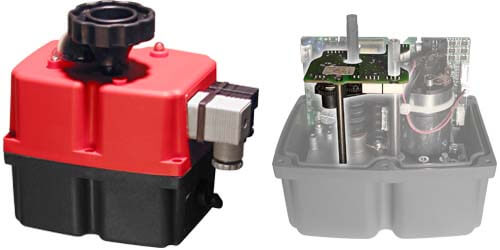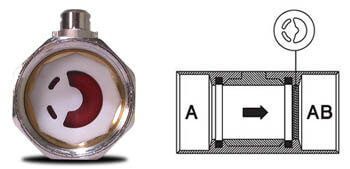| Order Online or Call Toll-Free 1-800-899-0553 | Log-in/Create Account |
|
|
We Make Valve Automation Easy
|
| Order Online or Call Toll-Free 1-800-899-0553 | Log-in/Create Account |
|
|
We Make Valve Automation Easy
|
A modulating control valve is an automated valve that is used to control the amount of flow in a system or process. They go beyond simple shutoff or isolation (on/off) and actually allow precise control of the flow rate. The actuators on these valves use feedback and control signals to accurately open and close the valve. There are two distinct types of valves that can be used for modulating control: "Rising Stem" and "Quarter-turn."
Both types operate using the same logic and principles. A control signal is sent to the actuator to instruct it on how far to raise or turn the stem. The control signal may be in the form of air pressure, or electrical voltage. For instance a 3-15 psi pneumatic signal will cause the actuator to completely closed the valve at 3 psi or lower, and completey open it at 15 psi or above. A 0-10 VDC electric signal will cause the actuator to completely closed the valve at 0 VDC, and completey open it at 10 VDC or above.
Typically there will be a flow meter downstream from the valve that measures the current flow rate, and sends that information to a control computer. The computer will apply the appropriate logic and generate the signal needed to adjust the valve in either direction until the desired flow rate is met.
Globe valves are one of the most commonly used for control applications. Globe valves have a disc shaped plug on the stem that is raised and lowered to control the degree of opening. They are ideally suited for control applications due to the internal construction, the way they operate, and the flow path.
Globe valves can be manually operated with a hand wheel, or automated with an electric multi-turn or pneumatic diaphragm actuator.
Quarter-turn valves include ball valves, butterfly valves, and plug valves. These types are mostly used as on/off valves that rotate 90 degrees from on to off. They are also referred to as stop valves, shutoff valves, or isolation valves. They are either completely open (90°) or completely closed (0°).
Quarter-turn valves can also be used for modulating control. When used as a modulating control valve they have the added ability to be accurately positioned at any point between 0° and 90°. This adds the ability to control the amount of flow in addition to whether there is flow or not. This is done by adding a quarter-turn rotary actuator with modulating capabilities. These actuators can be either electric or pneumatic.
Butterfly valves do a fairly good job as-is with no special consideration. In fact, most manually operated butterfly valves have multiple notches for the lever operator to lock into between the fully open and closed positions. The way a butterfly valve works does provide a gradual increase of flow throughout the 90 degree rotation.
Ball valves require special modifications to be effectively used in control applications. Standard port and full port ball valves do not increase flow evenly in relation to their degree of rotation. There are two methods used to achieve a directly proportional increase of flow with regard to degree of rotation. They are: using a V-port ball, or adding trim disc insert. See how these work below.

Pneumatic actuators require the addition of a positioner which can be pneumatic or electro-pneumatic. A pneumatic positioner receives a control signal in the form of air pressure. An industry standard for this type of signal is 3-15 psi. The positioner then converts this signal proportionally to a degree of rotation from 0 to 90. It provides supply air of the appropriate pressure to the actuator to achieve the proportional stem rotation. An electro-pneumatic positioner does the same using an electrical control signal in place of the air signal. These types of positioners are available on both spring return and double acting actuators. See our positioners for pneumatic actuators.

Electric actuators can perform the exact same function using a positioning circuit board inside of the actuator. This positioning board accepts an electrical control signal. Industry standard signals are 4-20mA or 0-10VDC. The actuator converts the control signal into the proportional degree of rotation and moves the actuator to that position.
A modulating option can be selected on most electric actuators. Simply check the "Modulating Positioner" option on the actuator selected using our automated valve configurators. See our electric actuators
One method of acheiving proportional control is altering the shape of the bore through the ball. This is called "characterization." V-Port ball valves use a special wedge shaped drilling to cause the flow rate to increase in a more directly proportional rate with the degree of rotation. Rather than a sudden increase when the valve is slightly opened, it gradually increases due to the narrow opening at the point of the v shaped port. The video illustrating the trim disc also applies to these v-ports.
A flow optimizing trim disc provides the same functionality as a v-port ball. In this case, the characterization is on the discs and the ball is still a full or standard port. The insert is placed directly on the downstream side of the ball and like the v-port it will make the flow increase proportionally with the degree of rotation.
